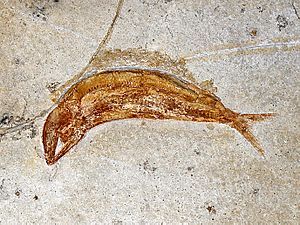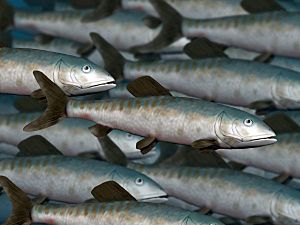Leptolepis facts for kids
Quick facts for kids Leptolepis |
|
|---|---|
 |
|
| Leptolepis knorri, from Solnhofen (Germany). Jurassic | |
| Scientific classification | |
| Kingdom: | |
| Phylum: | |
| Class: | |
| Order: |
Leptolepiformes
|
| Family: |
Leptolepidae
|
| Genus: |
Leptolepis
Agassiz, 1843
|
| Type species | |
| Cyprinus coryphaenoides |
|
Leptolepis (meaning "delicate scale") is an extinct type of fish. It lived in both freshwater and ocean environments. These fish swam the Earth from the Middle Triassic period until the Early Cretaceous period. Leptolepis is one of the very first groups of fish known as "teleosts." Teleosts are the most common type of fish alive today, including salmon, tuna, and goldfish!
Contents
What Leptolepis Looked Like
An average Leptolepis was about 30 centimeters (12 inches) long. It looked a lot like a modern herring, even though they are not closely related.
Leptolepis was one of the first true bony fish. This means its entire skeleton was made of bone. Earlier fish types, like Pholidophorus, had skeletons made of both bone and cartilage.
Another cool thing about Leptolepis was its scales. They were different from older fish scales because they didn't have a thick outer covering. These changes, along with a strong bony spine, made it easier for Leptolepis to swim. Its body could move in S-shapes more powerfully through the water.
Scientists think Leptolepis probably lived in schools. This means they swam together in large groups. Schooling helped protect them from bigger fish that wanted to eat them. They likely ate tiny plankton found near the water's surface. We know that Pelagosaurus ate Leptolepis. This is because a Pelagosaurus fossil was found with Leptolepis remains in its stomach!
Where Fossils Are Found
Fossils of Leptolepis have been discovered in many places around the world. They are found in rocks that formed in both freshwater and marine (ocean) environments. These fossils show that Leptolepis lived for a very long time, from about 242 million years ago to 112.6 million years ago.
You can find Leptolepis fossils in Eurasia (which includes Europe and Asia), North America, Africa, and Australia. This shows that these fish were very widespread across the ancient world.
Different Kinds of Leptolepis
Scientists have identified many different species (kinds) of Leptolepis. Here are some examples:
- Leptolepis africana
- Leptolepis brodiei
- Leptolepis coryphaenoides
- Leptolepis gregarius
- Leptolepis knorri
- Leptolepis macrophthalmus
Names That Changed
Sometimes, scientists learn new things about fossils. This can lead to changing the name of a species or moving it to a different group. For example, some fish that were once called Leptolepis are now known by other names:
- Leptolepis talbragarensis is now called Cavenderichthys.
- Leptolepis koonwarri is now called Waldmanichthys.
Images for kids
See also
 In Spanish: Leptolepis para niños
In Spanish: Leptolepis para niños




